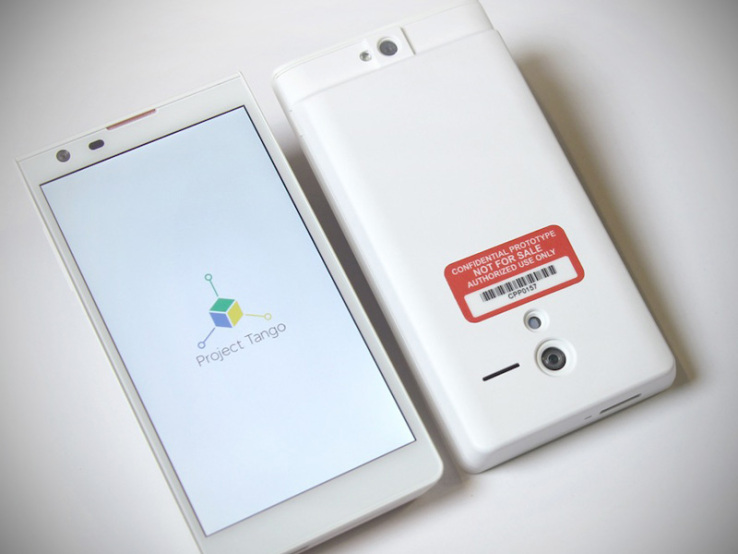Google Inc. (NASDAQ:GOOG), a name synonymous with innovation and known for its out-of-the box approach to things, has been in the news for famed developmental projects in the past. After few acclaimed projects, such as a Driverless Car, Project Loon (a network of balloons intended for beaming internet waves to far-reaching areas), Google Glass and Smart Lenses that can monitor glucose levels in the wearer’s body, the company is betting upon another path-breaking project again. This time it has revealed that its developers are developing a new kind of smartphone, dubbed as Project Tango.
Project Tango falls under the aegis of Google’s ATAP (Advanced Technology and Projects) labs. Unlike any random run-off-the mill smartphone, this is a device that intends to bridge the gap between the real and the virtual world. The realm of the virtual world is limited to the boundaries of a device’s screen. With Project Tango, Google aims at giving mobile devices a human-scale understanding of space and motion. Simply put, this is an experimental 5 inch smartphone that comes with multiple 3D sensors, remember Kinect?, that are able to map and measure surrounding environments by sensing and tracking motion and thereby create a 3D model or image of the corresponding environment(s).
Let’s look at the details about Project Tango:
- It is a 5 inch smartphone containing customized hardware and software designed to track the full 3D motion of the device, while simultaneously creating a map of the environment. This combined hardware and software allows the device to record over a quarter million 3D measurements every second which is followed by real-time updates in terms of orientation and position and combining all this data of the space around the user into a 3D model. Project Tango uses the Myriad 1 processor from Movidius to handle 3D sensing and imaging duties. They are also known as Computer Vision Processors. They provide for advanced motion and depth tracking without taking a toll on the battery back-up performance of the device. It somewhat functions like the M7 co-processor seen on the Apple iPhone 5S.
- This device runs on Android and offers development APIs (Application Program Interface) so that apps written in C/C++, Java and the Unity Game Engine can be easily developed for it and they are able to learn about the device’s position, orientation and depth.
- It combines a 4 MP camera to handle imaging duties and another motion tracking camera to handle the 3D imaging department. The 4 MP camera shoots standard resolution images and videos of the surroundings while the integrated depth sensing motion tracking camera shoots in a much lower resolution and prepares a 3D model of the surrounding environment.
If you’re wondering about the potential uses of a device that creates 3D models and images of its surroundings, well here are a few of them:
- It could be used as a navigation tool for moving within buildings or in mother indoor spaces thereby taking navigation beyond street addresses.
- This could also be the future of augmented reality or virtual reality entertainment and gaming as it would be able to include a larger number of models of real world objects into the virtual or digital spectrum.
- Since this device is a 3D mapping tool, it could also be used as a device to aid visually challenged user by alerting him/her of any undulations, disturbances and obstacles in the surrounding environment.
While Project Tango may seem to be very alluring and appealing on paper, it mustn’t be forgotten that this is just one of the many developmental projects undertaken by Google. It remains to be seen as to how and when will devices like this actually turn into reality and are made available in the mass markets. Many developmental projects never make it to the mass production stage but the lessons learnt from such projects eventually trickle down to subsequent production ready devices. I wonder how much of and how soon will the lessons learnt from this particular project be incorporated into Google’s own mobile devices.
Since this project is still very much in its nascent stage, information about it is pretty scanty and skepticism is high but Google is banking heavily on the performance of this research project and it has announced that it will be handing out a number of development kits of the Project Tango device to developers all around the world so that they can develop their own 3D mapping and imaging apps for it. A number of other MNCs and educational institutions, such as BOSCH, University of Minnesota and more, are also partnering with Google in this endeavour.
Google is looking for App development companies, who could join the project to build and test various apps for the smartphone. Google has 200 prototype developer kits to send to incorporated companies. All you need to do is tell them your idea, how do you plan to execute and if Google finds it interesting, you may get a prototype unit from Google to build and test your app. Interested incorporated entities could apply from here.
As we look forward to a new era of mobile devices and their uses, here’s wishing Johnny Lee and the entire Google ATAP team all the success as they tread toward a new dimension in the world of 3D imaging & mapping and augmented reality!
Here is a video about the capabilities about Project Tango:



